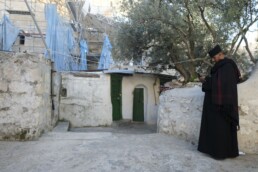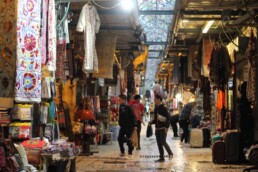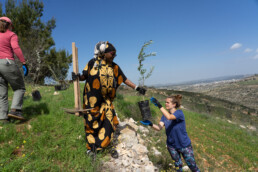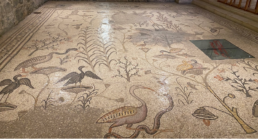In the Holy Land, Six Christian Faiths Jockey for Power at the Church of the Holy Sepulchre
As published in New Lines magazine
Aba Sibhat, an Ethiopian priest, types into his phone with a curious grin before he holds the Android device up to me.
“The Egyptian monks want to steal our church,” reads the text, Google-translated from Amharic.
For someone whose people have been at possible risk of eviction for more than 400 years, Sibhat looks relaxed, donning mirrored sunglasses as he sits under the shade of a tree on the roof of the Church of the Holy Sepulchre in Jerusalem. To Christians, this church, built on the site where people believe Jesus was crucified, buried and resurrected, is the holiest place in the Holy Land.
This Holy Week, however, might change his laid-back demeanor. During the days preceding Easter, which falls this year on April 9 for the Catholic and Protestant churches and on April 16 for the Orthodox Church, this rooftop becomes an ideological battlefield, where the Ethiopian Orthodox and Egyptian Coptic churches come to blows. At times, literally.
The Church of the Holy Sepulchre may well be the only church in the world where six of the most ancient Christian branches worship while rubbing shoulders. According to “Saving the Holy Sepulchre,” a book by Hebrew University professor Raymond Cohen, major communities like the Greek Orthodox, Roman Catholic and Armenian Orthodox churches have rights of possession and usage of all holy spots. The smaller Egyptian Coptic and Syriac Orthodox churches have limited rights to use the holiest places and almost no property rights over them. Instead, they preside over the other chapels, passageways and monasteries that sit close to the tomb of Jesus Christ. However, the Ethiopians have no rights in the church at all. They get to use only the roof.
In July 2002, a Coptic monk brought a chair up to the roof and sat under the shade of a tree — an action some interpreted as an act of war. Violent clashes quickly erupted between the Coptic and Ethiopian churches. Priests on both sides rolled up the sleeves of their God-ordained robes to throw ungodly punches and, in the melee, seven Ethiopian monks and four Coptic monks were injured.
Landlord quarrels do not tend to be resolved through the archaic, brute force methods of our ancestors but, in this case, such fistfights seem oddly fitting. This is because the two churches are, in fact, embroiled in perhaps one of the longest running property disputes in history. For more than 400 years, each side has purported to own the Deir al-Sultan monastery, which is located on the rooftop of the Chapel of Saint Helena. Because access to the courtyard where the monastery is located is through two adjoining chapels, ownership of all three is hotly contested. So is the right to repair a broken tile or sweep the floor, with any act possibly amounting to a claim of ownership.
Although the Ethiopian Orthodox and Egyptian Coptic churches have gotten into minor scuffles for centuries, things have been heating up again, said Hana Bendcowsky, a historian of the Christian quarter who works for the Rossing Center, a local Jewish-Christian interfaith organization. The Ethiopian monks have become more brazen, she said, perhaps as a result of growing nationalism against the backdrop of a civil conflict back home or because they have a larger African Christian population in the Old City, spurred by the arrival of several thousand Ethiopian and Eritrean asylum seekers, the latter of which totaled 71% of Israel’s 30,000 asylum seekers in 2020.
In 2018, the Ethiopian monks placed their flag on the roof and erected a tent, marking the monastery as their own and riling up the Egyptians, who responded by hoisting their flag alongside it and painting on one of the Ethiopians’ doors. In 2021, following a renewed flag standoff, Tarek al-Khawli, a member of Egypt’s foreign relations parliamentary committee, called the Ethiopian monks’ actions “thuggery.” This political reprimand did little to defuse the tension. Last year, the flag wars started again.
Fadi, who owns a souvenir shop in the no man’s land between the two feuding churches, is sure something will happen again during Holy Week. “It is a show, it is an act,” he said. “They have to do it every year to prove ‘this is our monastery.’”
The Ethiopians argue they have an early claim to Christianity’s holy sites, as some of the religion’s first supporters. They trace their presence in Jerusalem back to pre-biblical times, pointing to the story of the Queen of Sheba’s encounter with King Solomon around 1000 BCE. They also reference written accounts of Abyssinian people from European visitors, such as Jeronimo Lobo in the fifth century and Barbore Morsini in the 17th century.
The Copts, however, see the Ethiopian church as an offspring gone rogue. “Whatever you have is actually ours,” Bendcowsky says in explaining the Copts’ perspective.
When Ethiopia adopted Christianity in the fourth century, its new church was a “bishopric” of the Church of Alexandria and dependent on it. For centuries, all 111 of Ethiopia’s bishops were Egyptians, and the Ethiopians often brought the Copts gifts in the form of gold and animals to keep the archbishops coming, noted David Spielman, a historian of the Horn of Africa and visiting professor at New York University who focuses on early modern Christian Ethiopia. It wasn’t until 1951 that the Ethiopians called for their church’s independence and got their first Ethiopian patriarch, breaking the ancient Christian bond between the two countries. But, despite their emancipation, “this connection is always in the background of their relationship,” Bendcowsky says.
The Copts further claim that the Ethiopians are still present in the Church of the Holy Sepulchre only because of their church’s charity. For centuries, the Ethiopians had their own chapels inside the main church but grew extremely poor under Ottoman rule, cut off from the homeland and their emperor’s coffers, writes Kirsten Stoffregen Pedersen, a Danish nun and religious chronicler, in “The Holy Land Christians.” Around the 16th century, the Ethiopians, unable to pay the hefty taxes demanded by the Turks, lost all of their property rights to the Armenians and the Greeks. They managed to remain housed in the Deir al-Sultan monastery thanks only to the Copts.
In this case, kindness came at a price. According to Ethiopian accounts, when a plague (at times reported as a cholera epidemic) in 1838 killed all the Ethiopian priests at Deir al-Sultan, the Copts took the opportunity to reassert their claim with the blessing of Ibrahim Pasha, the Egyptian ruler who occupied the city of Jerusalem from 1831 until 1840. They burned all of the documents in the Ethiopians’ library, including their title deeds, arguing they were contaminated. The Copts got the keys to the chapels and the monastery, and the new Ethiopian arrivals became their guests. They were then relegated to the rooftop, where they built mud huts, later described derogatively by the BBC as reminiscent of a “basic African village,” and were forced to celebrate their Easter services under a tent in the courtyard.
Sibhat, the Ethiopian priest, shows me around these huts, though some sections look more like a Mediterranean fishing village — the walls of his small abode are painted in white chalk, his door a dark green to match the flowering trees and the artificial grass that is draped over a walkway.
Sibhat is proud of his amenities, showing off his fridge (which takes up an eighth of the narrow room), a kettle and the small light fixtures hanging overhead. The miracle of electricity and running water were a gift of the Jordanian government, which decided to upgrade the Ethiopians’ living quarters in 1966. Apparently, this did not please the Copts, who now prevent the Ethiopians from renovating their spaces, Sibhat says.
Written accounts suggest that, since antiquity, the Ethiopians have not been treated as “guests” as much as they have been barely tolerated residents. Samuel Gobat, an Anglican bishop who visited the monks several times in the 19th century, noted in a letter dated 1852 that the Ethiopians “were both intelligent and respectable, yet they were treated like slaves, or rather like beasts by the Copts and the Armenians combined.” The letter continued: They “could never enter their own chapel but when it pleased the Armenians to open it” and, on one occasion, were unable to “get their chapel opened to perform the funeral service for one of their members.”
That same year, it appears that the Ottomans grew tired of playing mediator to the many long-running disputes that sprung from the holy sites and reasserted a decree that had first been issued in 1757 but had been little adhered to. The “Declaration of the Status Quo in the Holy Places” proclaimed that whatever a religious group controlled or shared control of at that time would remain so: You could not ask for more, but you would not get less. To capture how significant this milestone was, one need only glance at a rickety ladder that has remained perched outside the entrance of the main church since the early 1800s — placed by the Armenians to have access to the balcony and angering the Greeks who shared it. No one is allowed to move it lest it disrupt the status quo.
Under this new decree, the Deir al-Sultan monastery would be shared by the Ethiopians and the Copts, while the two small adjoining chapels of St. Michael and the Four Living Creatures would be under the control of the Copts.
Yet, as any divorcee knows, forever can have an expiration date.
To get to the monastery, instead of walking through the main entrance of the Church of the Holy Sepulchre, one turns right, where a small door awaits and a quiet Ethiopian monk wearing a biretta nods and smiles at curious passersby. This chapel of St. Michael is constantly guarded by an Ethiopian, as is the second chapel of the Four Living Persons that sits between the lower level and the rooftop courtyard. But those who pay close attention (or are experts on Orthodox art) will notice that the iconostasis inside these Ethiopian-controlled spaces looks strangely Coptic, Bendcowsky notes. In other words, they are Egyptian-style.
The reason for the guards is that, with Israel occupying the Old City and the West Bank in 1967, the Ethiopian monks saw their fortune quickly change, and they took the opportunity to reassert their claim once more.
In a story recounted by Cohen in “Saving the Holy Sepulchre,” just after midnight on Easter Sunday in 1970, as Anba Basilios, the Coptic archbishop of Jerusalem, was leading prayer with his monks in the Church of the Holy Sepulchre, the Ethiopian monks used the cover of night to change the locks on the doors at both ends of the passageway — locking the adjoining chapels.
Basilus, upon hearing of this insurrection mid-prayer, asked one of his monks to check on the doors, where an Israel police officer stopped him in his pious tracks. Other monks who went the long way around to reach the upper level of the passageway found more police officers guarding the door to the second chapel.
On April 28, 1970, the Copts went to court to have the locks removed. Unfortunately for them, no court has the authority to decide on the merits of this or any other dispute. Property disputes with a religious flavor have fallen under the government’s purview since 1924, when the civil courts were told they could not deal with any “cause or matter” related to the Holy Places, religious buildings or sites. What the court could and did do was make a strong, moral declaration and hope the government would act on it.
In its decision on March 16, 1971, Israel’s supreme court criticized the police’s passive actions and ordered the Ethiopians to hand the new keys back. And even though the Israeli government had the right to create a committee to resolve the dispute and proposed doing so following the legal ruling, nothing in that vein has been set up in the five decades since.
But the fight over the Deir al-Sultan monastery does not exist in a political vacuum. Diplomatic jockeying has had an effect on ownership and access rights equal to that of claims of divine or historic prerogative, and the Ethiopian monks have benefited from certain collusion on the international stage.
In the 1950s, the newly born state of Israel had developed a burgeoning friendship with Ethiopia, as both were wary of Egypt’s President Gamal Abdel Nasser. For Ethiopia, the latter’s support for Eritrean independence was annoying at best.
Israel’s overtures to Ethiopia, on the other hand, were focused on its location close to the Bab al-Mandeb Strait, an important choke point that connected the Red Sea to the Indian Ocean and gave Israel trade access to Asia and Africa. In return for doling out modest amounts of economic development aid to Ethiopia — including via a police training program — Israel received access to the country’s ports, which was vital, as Ethiopia was the only country with a Red Sea coastline hospitable to Israeli ships.
So strong was their bond that, in 1973, the Libyan leader Moammar Gadhafi threatened to boycott, rather than celebrate, the Organization of African Unity’s 10th anniversary unless the venue — the Ethiopian capital of Addis Ababa — was changed, accusing the hosts of supporting “the Zionist enemy.” As African countries severed ties with Israel, Ethiopia quietly remained an ally, accepting clandestine assistance.
This made sense in the new world order. The Derg, the communist regime that deposed Ethiopia’s emperor in 1974, was convinced that several of its Arab neighbors wished to turn the Red Sea corridor into an “Arab Lake,” aspiring to impose an “anti-Ethiopian puppet regime in Eritrea that would join the Arab League.” Israel appeared to sympathize with this view, albeit quietly, training the future bodyguards of President Mengistu Haile Mariam as well as paratrooper and counterinsurgency units belonging to the Fifth Division.
While being outwardly pro-Palestine, Ethiopia accepted Israeli air-to-air missiles, napalm, cluster bombs and spare parts for its tanks and planes to fight against neighboring Somalia and an Eritrean uprising in 1977 and 1978. Israelis were expelled only once news of their illicit affair became public in 1978, when Foreign Minister Moshe Dayan confirmed press reports that Israel was selling arms to Ethiopia’s Marxist government.
The ties are even stronger thanks to another religious connection. “Ethiopia is viewed by Jews largely as almost a place where brothers or long-lost family are from,” Spielman explains. Thousands of Beta Israel, as Ethiopian Jews are known, were airlifted to Israel in 1984 and 1991 in several rescue missions. This year, about 1,500 are expected to make aliyah, according to the International Christian Embassy Jerusalem, which sponsors many of their flights.
Historically, even the Ethiopian Orthodox Church has been viewed as “too Jewish,” Spielman notes. In the Middle Ages, Ewostatewos was one of the Orthodox priests who advocated for the Sabbath. His Judaizing ideas landed him in a Coptic court in Cairo, where he was charged for wanting to observe the Jewish day of rest as well as Sunday, writes historian Tadesse Tamrat in “Church and State in Ethiopia.” Though Ewostatewos was ultimately exiled, Ethiopia’s Orthodox Church has maintained the tradition — Saturdays are off.
This religious history has contributed to the current controversy over the Grand Ethiopian Renaissance Dam. It does not help that, in the past, Ethiopian emperors have “threatened to block the Nile in retaliation” for the persecution of Christians by Egypt, Spielman recounts. That Egyptians now appear to suspect Israeli involvement and have levied accusations that it has helped Ethiopia build and defend the dam is rooted in this historical drama. The Israeli Embassy in Cairo posted a tweet on July 18, 2021, denying such claims, after reports (that were also denied) that Israel had supplied missile batteries to the Ethiopians and its engineers were working within Ethiopia’s Ministry of Water, dishing out advice and supervising some work on the dam, as detailed by Zvi Barel in an article published in Haaretz in 2021.
In a strange, indirect way, the Ethiopian monks in Jerusalem continue to benefit from the trickling down of political games. As long as Ethiopia remains in good standing with Israel and Egypt is seen as an ongoing or potential threat, certain monks will likely continue getting preferential treatment over others, their brazen actions going unchallenged (or protected by guards), even if it means ignoring the status quo.
On Easter night, Ethiopians — dressed in their traditional white gabi robes and woven cotton dresses — congregate on the rooftop with candles to celebrate the miracle of the Holy Fire. To them, the presence of Ethiopian monks in the holiest place in Jerusalem is more than just a point of pride. It serves to validate the deep roots of their faith, the community’s long ties to the region and to a religion that has shaped its kingdom, country and people.
Celebrating, however, is becoming harder and harder each year.
This is because Ethiopian Christians in Israel face a two-fold challenge. Not only have they faced historical discrimination for being Black, but they are also at a disadvantage as non-Jews. One Ethiopian Christian woman residing in Tel Aviv commented that her work colleagues think she is an Ethiopian Jew, an assumption she has never corrected because “passing” as one is easier in this climate. She even decided against getting a tattoo of an Ethiopian cross to avoid questioning glances.
But the Copts are suffering, too, amid a rise in Jewish attacks on Christian sites in Israel, coupled with an ever-dwindling Christian population in the Holy Land, which has struck fear in the community. Mother Agapia, a U.S.-born Russian Orthodox nun who used to live in Jerusalem, suggests that this period of infighting and insecurity could serve to “unite the Christian communities.”
Bendcowsky appears to agree. Despite the forced coexistence in the Church of the Holy Sepulchre, the place “functions in a miraculous way,” she says, with all its pilgrims, tourists, liturgies and monks — a message she tries to emphasize at the end of her tours of the Christian quarter.
Sibhat and the other Ethiopian and Coptic monks are part of the same team. Certainly, they are considered ecclesiastical siblings, and the only true owner of these assets is the common God to whom they pray.
Amid Israel Protests, ‘Passover Table is the New Thanksgiving Table’
As published on Religion News Service (RNS).
As Israelis continue to protest in unprecedented numbers against Prime Minister Benjamin Netanyahu’s proposed overhaul of the judicial system, political tensions arise within Jewish families during Passover.

JERUSALEM (RNS) — For Passover, Tsiyona Sharvit, an Israeli woman who lives on a kibbutz in a West Bank settlement, plans to join the holiday meal of the family of her daughter’s partner. It’s the first time she’ll be meeting them, which should be an exciting time for her, but Sharvit admits she’s worried about what to do if political talk breaks out at the Seder table.
An observant Jew, Sharvit normally looks forward to the holiday and its celebration of Jews’ delivery from Egyptian slavery. This year, though, it’s felt overshadowed by unrest in her country, as tens of thousands of people in Israel have gathered to protest efforts by Israel’s right-wing coalition government to overhaul the country’s judicial system. Sharvit, who said she leans conservative politically, has participated in protests. And although her family has not experienced division around politics, she can’t say the same for many of her friends.
“I have friends who have asked me to spend Passover with them because they aren’t speaking to their families,” she said. “They’re really angry.”
One friend, she said, canceled plans with her sister to celebrate the holiday after an argument over the protests. They had spent almost every Passover of their lives together.
For 12 weeks, protesters have been attending demonstrations across Israel in record numbers. According to recent polling from the Israel Democracy Institute, roughly two-thirds of Israelis oppose the judicial overhaul. Many citizens — like Sharvit and her friends —believe the future of Israel’s democracy is at stake.
The proposed changes would grant the elected government control over the choice of judges and diminish the power of its legal advisers, limiting the Supreme Court’s power to rule against the legislative and executive branches and affecting the government’s system of checks and balances.
Although Prime Minister Benjamin Netanyahu has put the changes on pause amid public outcry, protests and labor strikes, the issue remains a live wire — even for those outside of Israel.

“He’s just buying time. That’s what he’s trying to do,” said Einat Admony, an Israeli-turned-New Yorker protesting outside the Israeli Embassy in Manhattan last week.
Admony owns Balaboosta, a critically praised Israeli restaurant in the West Village. While working full time as head chef, she’s also been active in demonstrations — which many of her family members in Israel don’t support.
“It’s been mixed opinions,” Admony said. “Which sometimes leads to tough conversations and screaming like crazy.” Admony said this year, she’ll remain in the States during Passover.
“Passover table is the new Thanksgiving table,” added Basya Gartenstein, referencing a timeworn tradition of fraught conversations when different generations of family get together over turkey and mashed potatoes.
Sara Tesler, a mother of five who lives in the West Bank settlement Efrat, agrees: Everything’s political right now, though she acknowledges life in Israel has often circulated around politics even before these demonstrations.
“Like, where do you buy your milk? Where do you send your kids to school?” she said. “Which roads will you drive on and which ones you don’t?”
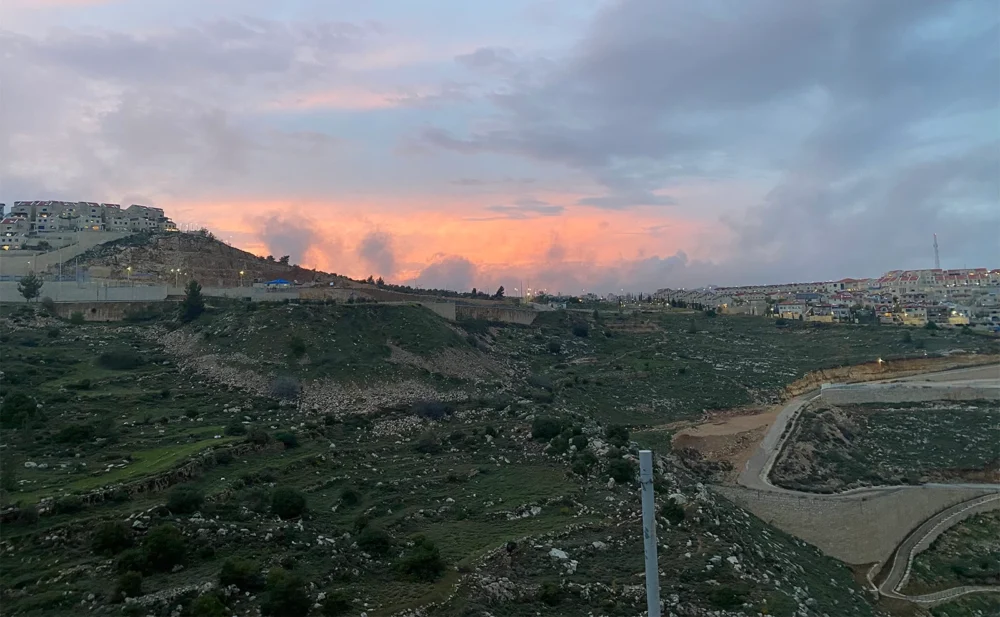
An American who immigrated to Israel seven years ago, Tesler attends weekly protests in her settlement. She doesn’t go to larger demonstrations in cities like Jerusalem and Tel Aviv because she wants her neighbors, who she says are split 50/50 on Netanyahu’s proposed judicial changes, to see her stance on this issue. However, she does this without her husband, who doesn’t approve of the demonstrations.
“He feels like there’s never any nuance at a protest,” she said.
He believes they attract extremists and “a lot of people on the fringe,” she added.
Despite their differences, Tesler said she and her husband are expecting a peaceful Passover. They’ve always followed the precedent of no politics at the dinner table, and that’ll be a rule that’s doubly reinforced this year, she said.
But it’s tough to be apolitical in this environment, said Israeli public opinion expert Dahlia Scheindlin, who noted the protests aren’t compartmentalized and have edged into most aspects of life in Israel, including home life.
On March 25, more than 630,000 people attended demonstrations all across Israel — the largest demonstration in the nation’s 75-year existence. The sheer momentum of these weekly demonstrations for multiple months is historic, according to Scheindlin, who for 20 years has advised on campaigns in Israel as well as more than a dozen other countries,
“It’s very rare for a protest this big to go for so long,” she said, noting that outside of ultra-Orthodox communities, who are vastly in support of Netanyahu, the Israeli protesters have been diverse in age, gender and commitment to faith.
“Right-wing people are scared to see how many actors are in on this,” said Scheindlin.
On a recent Saturday in Jerusalem, Yael Ziv, Israeli flag in hand, arrived early to join a growing group of protesters outside the president’s residence as they geared up for another night of demonstrating.
The daughter of Holocaust survivors, Ziv, 75, said it’s challenging to witness families clash over this issue in a nation that’s supposed to be a designated safe space for Jews and “the only country in the world where Jews can feel that they are among themselves.”
“My friend just told me that his 30-year-old son decided not to join the family celebration in order to avoid explicit and painful conflict,” Ziv said.
But she believes there are important issues at stake and that protesting will “bear peaceful fruits,” regardless of the cost to people’s personal lives.
“Our pride is that we used to have a democratic country. Now the threat is that this will cease to be a democracy,” she said.
“The Jews suffered when we were not in a democracy.”
Amid Israeli Red Tape, Married Palestinian Couples Struggle to Remain in Jerusalem
BETHLEHEM, WEST BANK - In 2015, on the first evening of the Christian camp, Maria* and Michal met for the first time. After dinner, they peeled away from the crowd to admire the statue of the Virgin Mary that stood at the front of the church. Maria, who was 18 at the time, sat in an empty church in the West Bank, deep in conversation with a man who would soon become her husband.
Maria and Michal grew up within a 15km radius of each other — her in Jerusalem and him in the West Bank. As they sat under the watchful eye of the mother of Christ, they talked about everything — their families, their devotion to their faith, their love for their land.
“It was so natural and easy to speak with him — we connected on so many levels,” said Maria.
The two fell in love that night and got married in July 2022. For Maria, getting to marry Michal was a victory — she had to face many hurdles to get there.
“My dad was initially quite resistant to the idea of us getting married,” said Maria.
Maria's father, Joseph*, 58, is a tour guide who was born in the old city of Jerusalem. His hesitancy with his daughter’s marriage steamed from hardships he faced from his own experience marrying Maria’s mother, Grace*, 53, because she is also from the West Bank.
“I did not want my daughter to go through all the hardships my wife and I faced,” said Joseph.
Both Joseph and his daughter were born in Jerusalem, which means that they have a Jerusalem identification card. This card allows them to move freely through checkpoints between checkpoints between Jerusalem and the West Bank. Grace and Michal, on the other hand, were born in towns in the occupied West Bank which means they are not entitled to a Jerusalem identification card.
To obtain one, Grace had to apply for a special residence permit through the Ministry of the Interior in Israel. However, applying for this permit is challenging. Joseph and Grace had to wait for 20 years before they finally obtained this permit. During that time, Grace had to constantly reapply for a work permit to stay in Jerusalem every few years. They managed to stay together in Jerusalem but were never fully confident that they would not be separated.
Joseph and Grace faced several ups and downs over the 20 years, but the one thing that helped Grace overcome challenges was her faith. Every week, she would go to the Church of the Holy Sepulchre to pray. As she kneeled by the marble slab near the entrance where Jesus was laid, she prayed for her family and for her fellow Palestinians in the same situations. For Grace, praying at the Church of the Holy Sepulchre was a blessing, and she believed that whatever she asked for will be fulfilled.
“Jerusalem is a very holy place. I have faith that it is worth staying here. I know I will be able to fulfill my life as a Christian here,” said Grace.
When Joseph and Grace got married in 1996, they moved into Joseph’s parent’s house in the Muslim quarter of Jerusalem. At that time, Joseph worked in accounting and was adamant about staying in Jerusalem to maintain his own ID. While Palestinians born in Jerusalem are born with the right to an identification card, they also go to great lengths to maintain their Jerusalemite status. Those with the ID must be able to prove that Jerusalem is their “center of life”. This means that they need to remain in Jerusalem and be able to prove that they spend the majority of their time there.
For Joseph, this meant living in the same house his parents owned since he was young, collecting electricity and water bills to prove that he was using the residency monthly. He even had to ensure that his fridge was stocked with food to prove that he lived at home as Israeli government officials sometimes came to check. Despite the challenge, it was worth it.
“As a Palestinian, and as a Christian, we must continue our presence here in Jerusalem,” he said.
Palestinian Christians currently make up around 1% of Jerusalem’s population, but the number of Christians have been slowly dwindling. For Joseph, staying in Jerusalem despite the falling numbers is his way of defying expectations and ensuring that those like him are still represented. For this reason, he became a tour guide.
“I want people to know that this place, which is so important to Christians, still has Palestinian Christians, I want them to know our history,” said Joseph.
When Joseph and Grace got married in the late 1990s, the situation with the security checkpoints between Jerusalem and the West Bank was different than they currently are. Even though the checkpoints existed, it was easier for Palestinians to move in and out of Jerusalem as they did not always require a permit to do so. It wasn’t until a period of unrest known as the Second Intifada in the early 2000s when security on the Israeli side got much stricter and all Palestinians were required to have a permit when moving into and out of Jerusalem.
Things became a lot more challenging for the couple after that — Grace had to constantly reapply for a work permit to stay in Jerusalem and was in constant fear that she could lose it at any moment. Palestinians without an ID also undergo much more scrutiny when crossing checkpoints than those with an ID.
Whenever Grace and Joseph would drive through a checkpoint, Grace was required to step out of the vehicle and walk through a separate line with body scanners while her husband and kids were able to pass through the checkpoint in the comfort of their car. Once she passed through the other side of the metal detectors, she usually had to trek a couple of kilometers on foot past the intimidating barbed wires to where Joseph and the kids were waiting for her. At times, the officers manning the checkpoints would take a break, and those in line would be stranded for hours, hoping that someone would return so they could cross to the other side.
“It was so humiliating and dehumanizing,” said Grace. “Having your kids watch you go through is something I wish no one has to go through."
This process still stands today. Whenever Maria and Michal cross the checkpoint into Jerusalem, Michal has to get out of the car while Maria stays in the vehicle.
“We try to avoid going into Jerusalem because of the checkpoint,” said Maria. The pair currently lives in Kafr Aqab, a neighborhood at the edge of Jerusalem designed for couples where one has the Jerusalem ID and the other does not.
Grace also avoided crossing the checkpoint as she was fearful of the process. During the 20 years she lived without an ID card, she visited her family maybe a handful of times. She would long to go back to Ramallah to see them during Easter and Christmas, significant times of year for her as a Christian, but often opted out because of fear and embarrassment.
“One year, I just chose to stay home because I knew I would not be able to get through even though I wanted to go with my kids and see the lights,” she said. “I remembered just crying that entire night knowing I could not experience it.”
In late 2003, Grace's father fell gravely ill. However, Grace’s work permit had expired and as she waited for a new one, she knew that she would not be able to visit Ramallah and then return to Jerusalem to be with her kids. Though it was an incredibly painful decision, she could not leave Jerusalem to visit her family. She did not get to see her father during his last few days and was unable to attend the wedding.
“It is something I still think about, and it makes me really sad,” said Grace.
In addition to difficulties at the checkpoint, the cost of living in Jerusalem was another struggle for Joseph and Grace. As a Jerusalemite, Joseph had access to healthcare from Israeli institutions, but Grace did not. They had to opt for private insurance for her, which was incredibly expensive.
For Joseph, practicing his faith gave him strength to face the hardships. He thinks of the story of resurrection whenever things get challenging.
“Jesus rose for us. It gives me strength because I will continue to rise and keep going,” said Joseph.
In 2013, Joseph and Grace approached a lawyer who was working with several other families who were also trying to obtain a Jerusalem ID card. The process cost them around $8,000 USD. In 2016, Grace finally obtained her identification card.
“I was so happy. The first thing I did was take a picture and send it to my sister,” said Grace.
The second thing she did – drive through the Hizma checkpoint, a checkpoint she said she was never able to get past when did not have her Jerusalem ID card.
After reflecting on her experience, Grace's tone grew somber thinking about what her daughter must undergo.
“I want an easy life for them. I don’t want them to suffer how I had suffered,” said Grace.
Maria and Michal want to apply for the special permit but must wait until Michal turns 35 because the application mandates that men must be at least 35 years old before applying. As of March of this year, the Knesset passed the Citizenship Law, which denies Palestinian naturalization into Israel. Under this new law, Palestinian couples can obtain a residency permit which lasts for up to two years. However, this residency permit can be revoked at any point in time on security grounds.
Though Maria is worried about this new law, and knows that the road ahead for her and her husband will not be easy, she is not ready to give up just yet.
“Religion was the most powerful engine that helped my parents stay in Jerusalem.” said Maria. “I hope it will help us, too.”
* The sources requested that we publish only their Christian first names to avoid being identified because they feared retribution by the Israeli government.
The Last Palestinian Hill: Palestinian Farmers Peacefully Resist Israeli Efforts to Confiscate Land
ON A HILLTOP OUTSIDE OF THE WEST BANK CITY OF BETHLEHEM – The Rev. Terry Oliver, a Christian minister and grief counselor from outside of Seattle, Washington, knelt in front of a freshly dug hole in the rocky soil at a Palestinian family farm here called The Tent of Nations. He took a fragile olive sapling and gently placed it in the soil. As he filled the empty spaces around the roots with dirt, he intoned this prayer:
“We bless you, olive plant. In the name of the Lord, may you grow healthy, survive and provide plentiful olives, fruit for the healing of the nations, oil to gladden our face and somewhere close, wine to gladden our hearts.”
The planting was a small act of resistance and hope on the last Palestinian hilltop in this area known to Israelis as Gush Etzion. All the other hills, occupied by Israel since 1967, have been settled by Israelis seeking to claim what they see as their Biblical homeland.
The Tent of Nations is the name of the Nassar family’s farm. As part of their peaceful resistance, the organizers invite Christian pilgrims and Israelis sympathetic to their cause to work the land. One recent spring day, Daoud and Daher Nassar led a group of volunteers down the terraced hill, traversing the rocky, steep terrain of their farm. At the edge of the property, as far as the eye can see across the valley, Israeli settlements, which are illegal under international law, are perched upon neighboring crests, markedly identified by fortified fences surrounding them.
With olive trees and farming tools in hand, the volunteers continued the Nassars’ long term project: to cultivate the land and replace some of the almost 1,000 trees, including hundreds of mature olive trees, that were damaged or destroyed after they were set afire two years ago.
It remains unclear who set the Nassars’ trees on fire. Some suspect Israeli settlers motivated by religious zeal to claim what they see as the Biblical land that is their Jewish inheritance. But the Nassar brothers do not dwell on blame. They remain committed to one guiding principle, informed by their Christian beliefs and rooted in their commitment to peaceful resistance; “We refuse to be enemies,” Daoud said.
With refusal to resort to violence or resignation, the Nassars have pursued an active approach to resistance and repairing harm; what Daoud described as “acting instead of reacting.” Nevertheless, he explained, “We might act non-violently for years and years, but the outcome is also violence,” noting the impact felt on his family and farm.
He continued, “Nonviolence is not the absence of violence, as Martin Luther King said.”
Despite a catalog of attacks on his family and farm and Israeli attempts to confiscate the land, his emphasis remains on reclaiming and rebuilding the land that he says was bought by his grandfather more than 100 years ago.
On this temperate March morning, a dark, velvety rainstorm loomed in the distance as volunteers from all around the world gathered at the Tent of Nations to plant 150 olive trees, part of the farm’s tree planting campaign. They are among the continual stream of volunteers visiting the farm, providing an international presence, which the family relies on as a deterrence from Israeli state action and further attacks. This was the vision when they launched the Tent of Nations project in 2001, establishing the farm as a space for international congregation; where volunteers help to farm and cultivate the land and help see other projects come to fruition and can offer financial support.
Nassar Farm, now run by Daoud and his siblings, is situated in Area C of the West Bank — under Israeli administration — where building upon the land is illegal without permits. In the Nassars’ experience, these permits are never granted. Meanwhile, he watches as permits are issued for the neighboring Jewish settlements. The Jewish settlements also get services that he lacks, like access to running water and electricity. The Gush Etzion settlement bloc, occupied by Israel in 1967 and constructed over the decades since, spans neighboring hilltops. The bloc surrounds the small Palestinian village of Nahaleen in the valley below. Its name is Arabic, meaning “those who collect honey from bees,” an emblem of the region's agricultural history.
Daoud’s grandfather was a Palestinian farmer and observant Lutheran. On the farm today, a cave that he used as a chapel, remains carved into the ground next to the pen of the farm’s donkey, Vicki. Above the stone archway leading to the cavity is a red cross. Caves are another distinctive feature of the farm; they provide necessary shelter while permits to build housing — and other infrastructure — remain ungranted. Daoud Nassar recalls that his grandfather would often finish each day with his children reciting prayers as they watched the sun sink beneath the horizon. He dreamt that his children and the generations after them would have a physical and spiritual connection to this unforgiving land — the way he did.
As a young, aspiring grape farmer and vigneron, the grandfather bought this land, positioned just Southwest of Bethlehem. He registered it under the British Mandate in 1924 and 1925.
In 1991, Israel designated Nassar farm as state land and announced its intention to confiscate it from the family. The Nassar family took the government to court noting that it had ample documentation of ownership. Since then, they have been ensnared in a legal battle over the land. With increasing legal expenses which Daoud said totals over $200,000 and at the mercy of a court date to register the land with Israel which continues to be pushed to a later date, uncertainty looms over the farm's fate. The next court date is scheduled for May 15th, in which there will be a hearing where the last objection to the Nassar’s claims to the land’s title will be heard.
Today, in the face of this uncertainty, the Nassar family maintains a steadfast belief in this inherited dream and the vision of their forefathers. As their land continues to be threatened, they are committed to channeling their energy into creative solutions.
While the Nassars have been forced to use solar power, collect rainwater and build underground, the neighboring settlements have been mushrooming around them. As a stark contrast, just one of the settlements, Betar Illit has a population of over 60,000, with virtually unfettered access to running water and electricity.
Daoud’s story as a Palestinian family is not unique, although the hundreds of thousands of dollars of international support and volunteers like the Pastor who have enabled him to stay is.
As Oliver intones his prayer, he, his fellow pilgrims and volunteers know that only against many odds will the olive trees eventually bear fruit. Volunteers present for the recent tree planting campaign largely included international students from Hebrew University’s Christian prayer group. One student, Krystal White, organized the trip with her group as she said she felt compelled to return after her first visit in November of 2021. With instruction from the Nassar brothers, the volunteers grabbed their picks and began to dig. Charcoal earth and rocks stained by ash were still faintly visible from the assault in May of 2021.
One of those volunteers is Noa Randall, a 26-year-old environmental scientist from Cambridge Massachusetts, who spent two weeks at the farm. She wanted to see for herself what it means for Palestinians who are surrounded by settlements and face difficulty accessing their land. She said watching the Nassar family tirelessly defending their land left her speechless.
“This is an image of what resilience looks like.”
Photos:
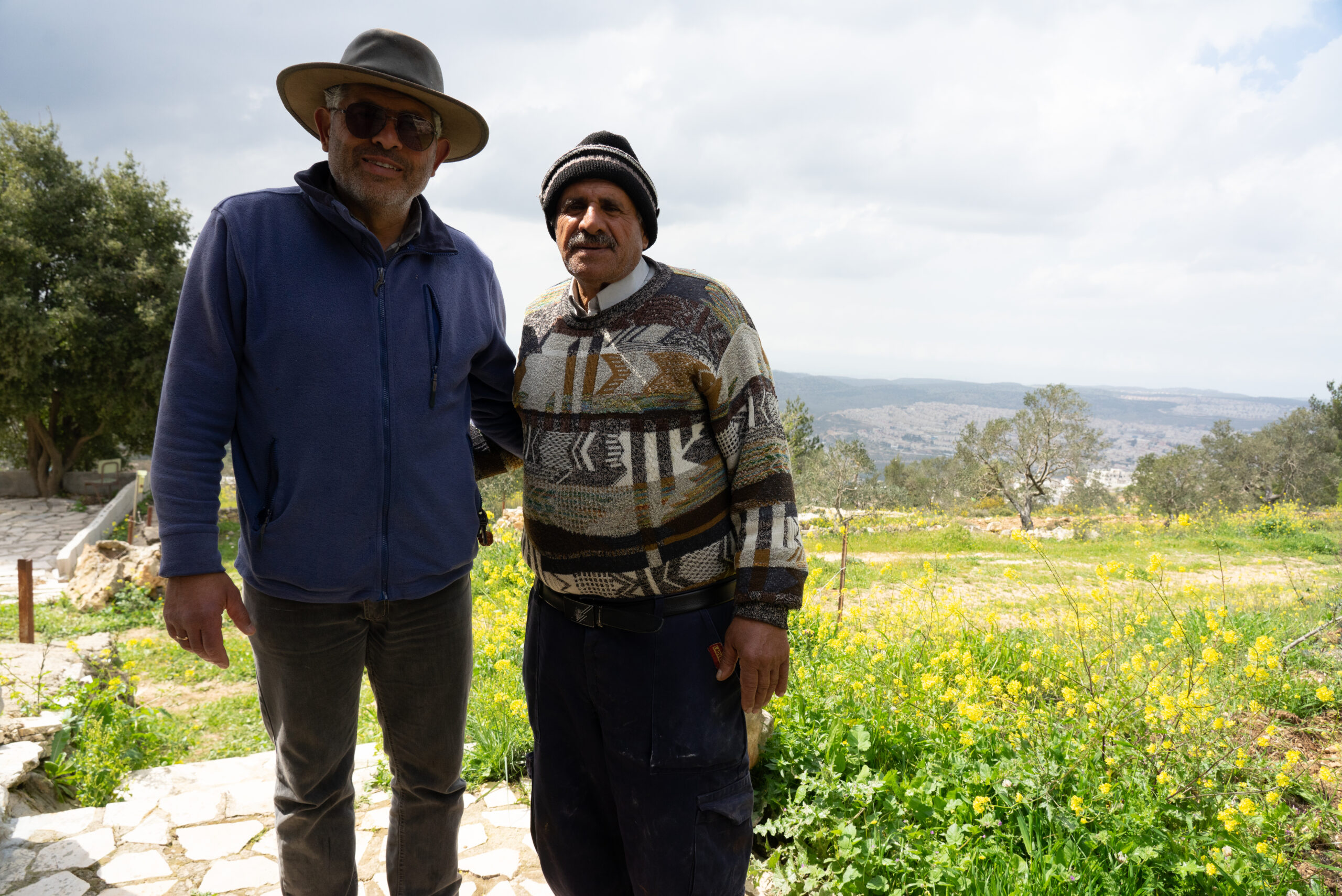
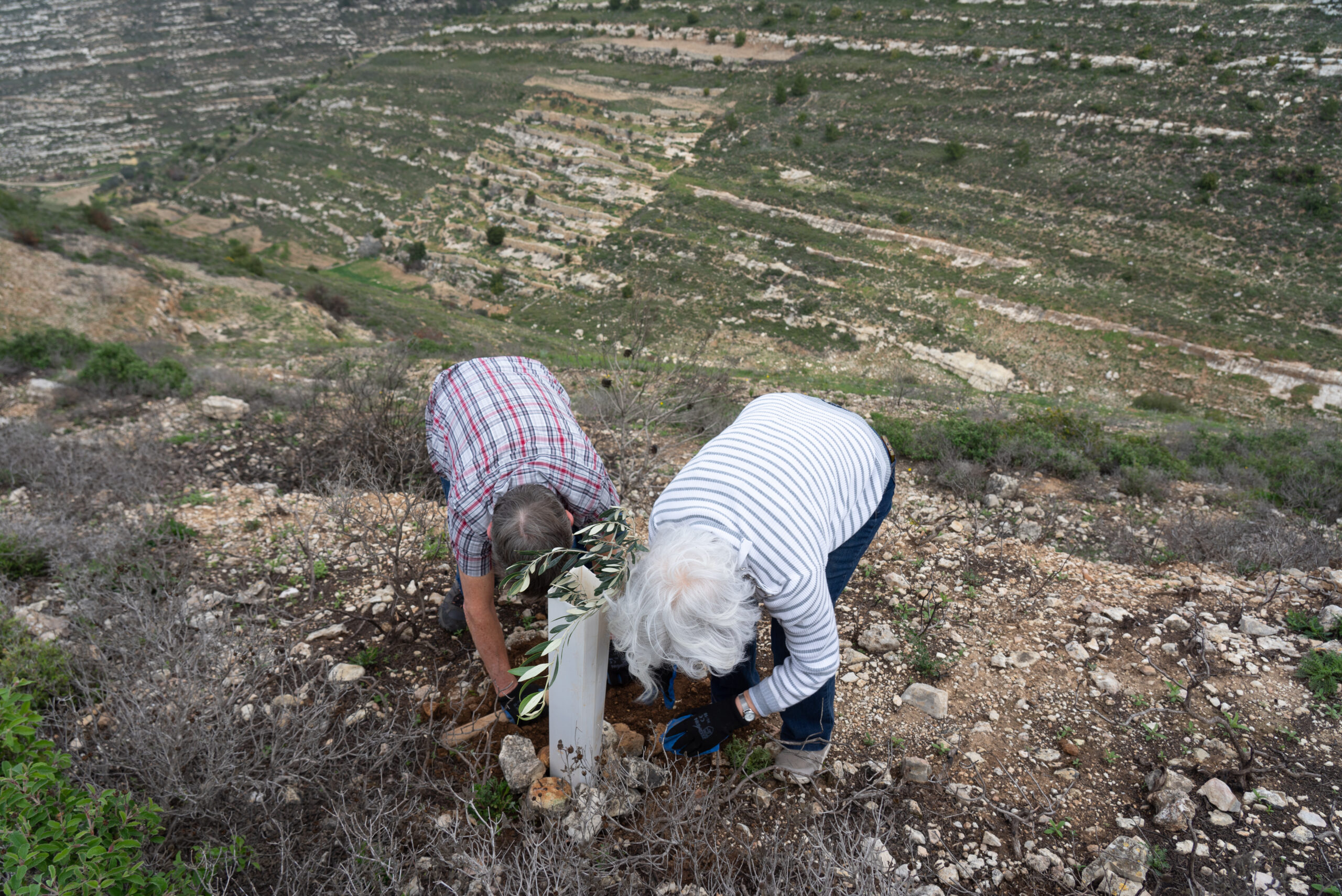
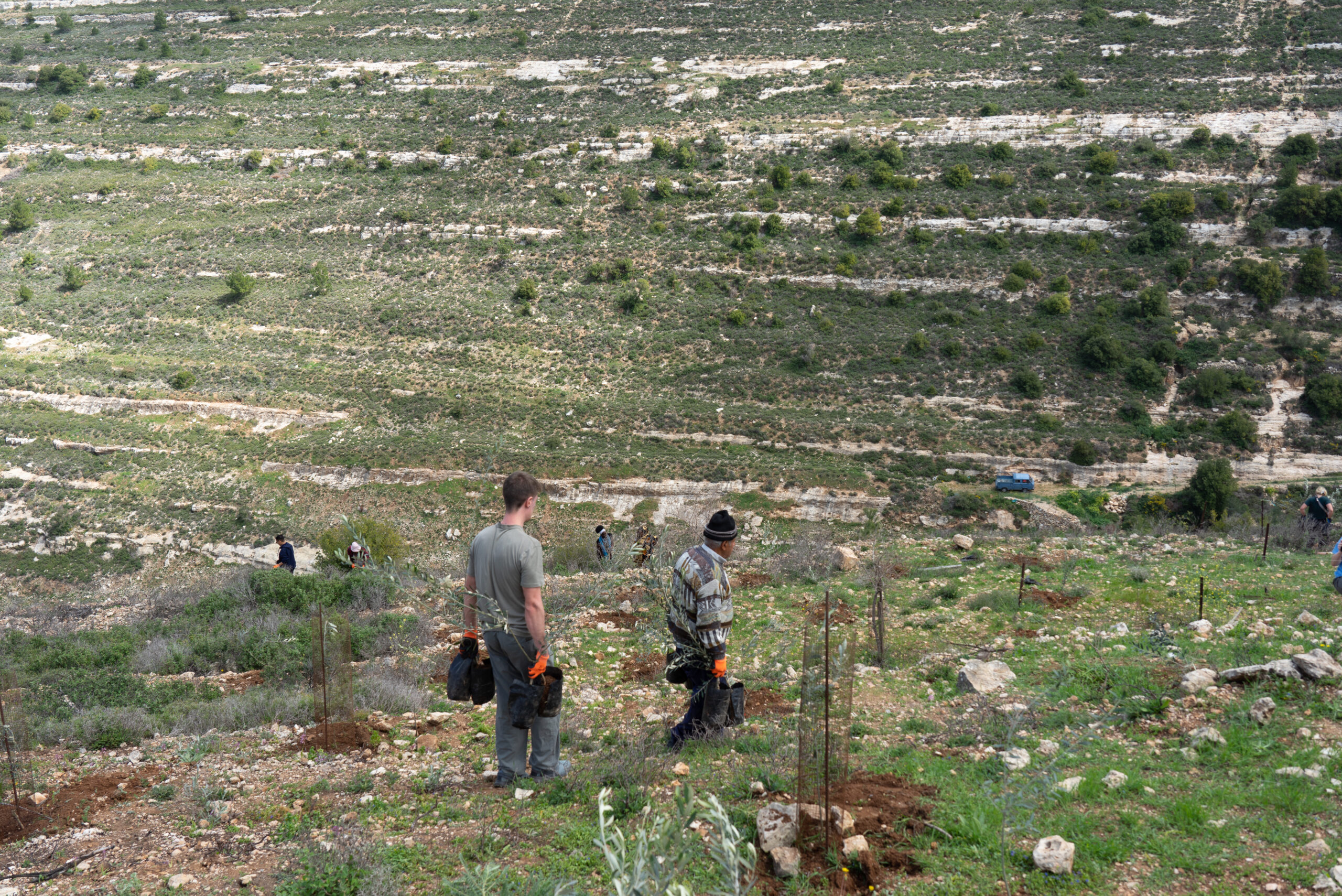


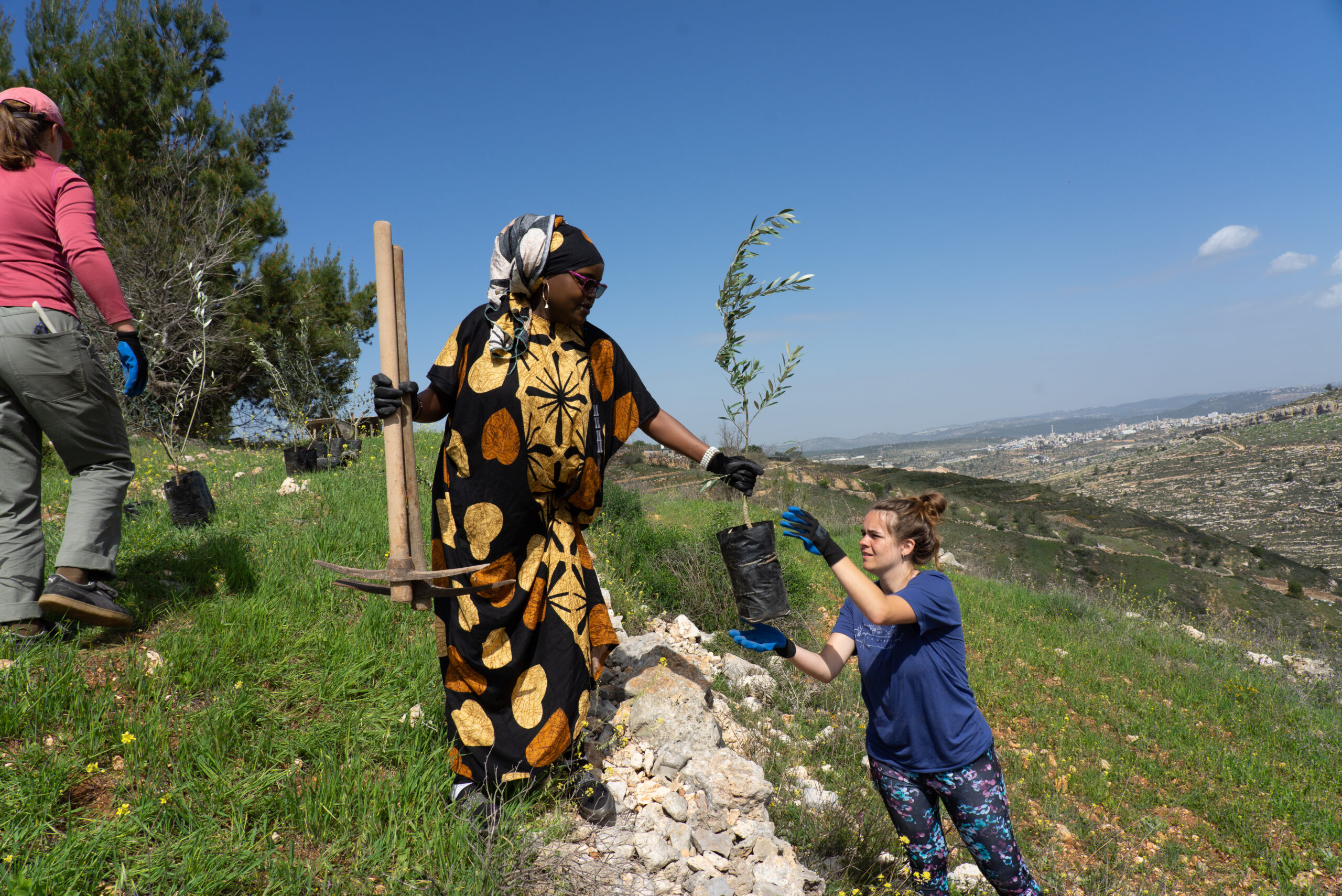

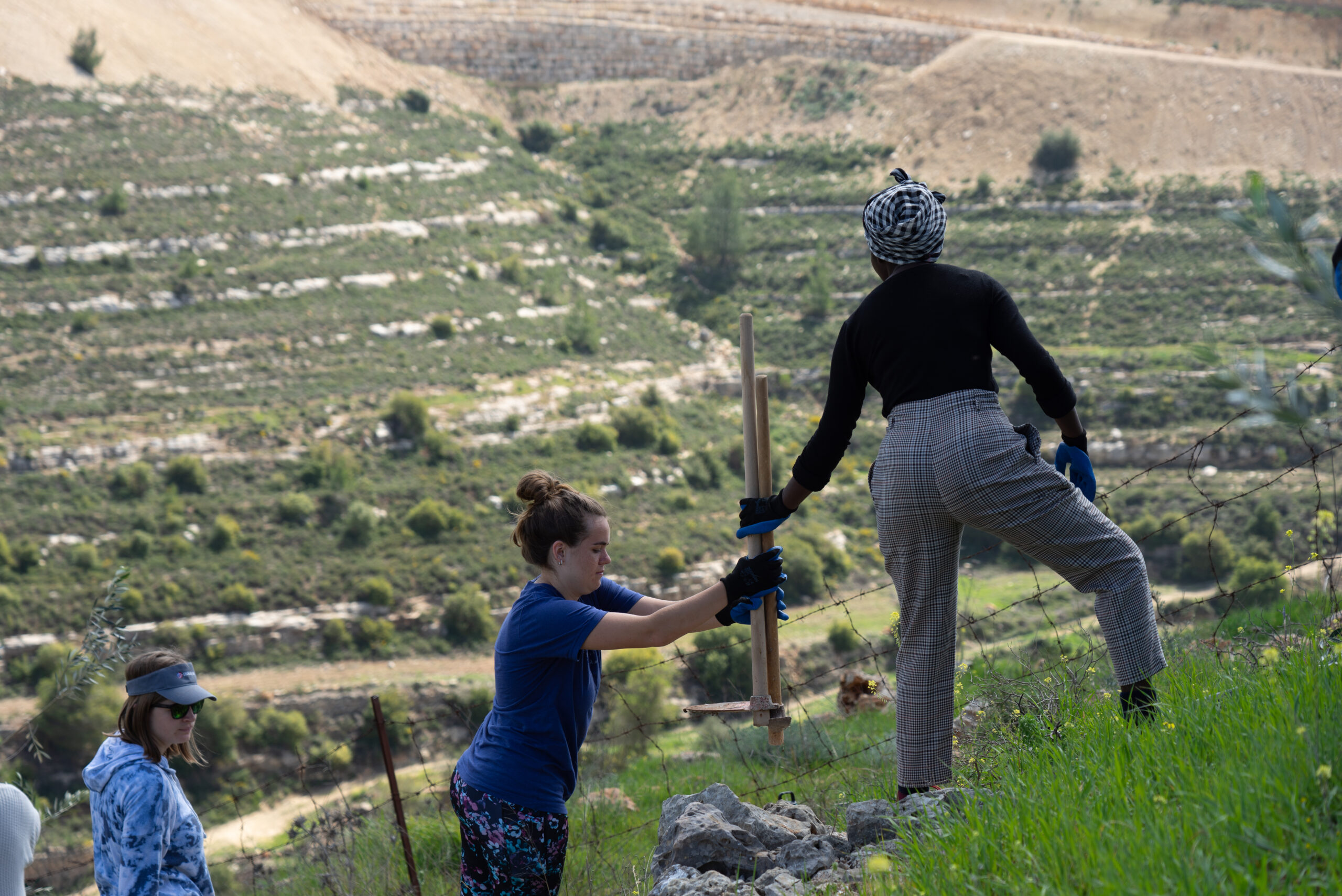
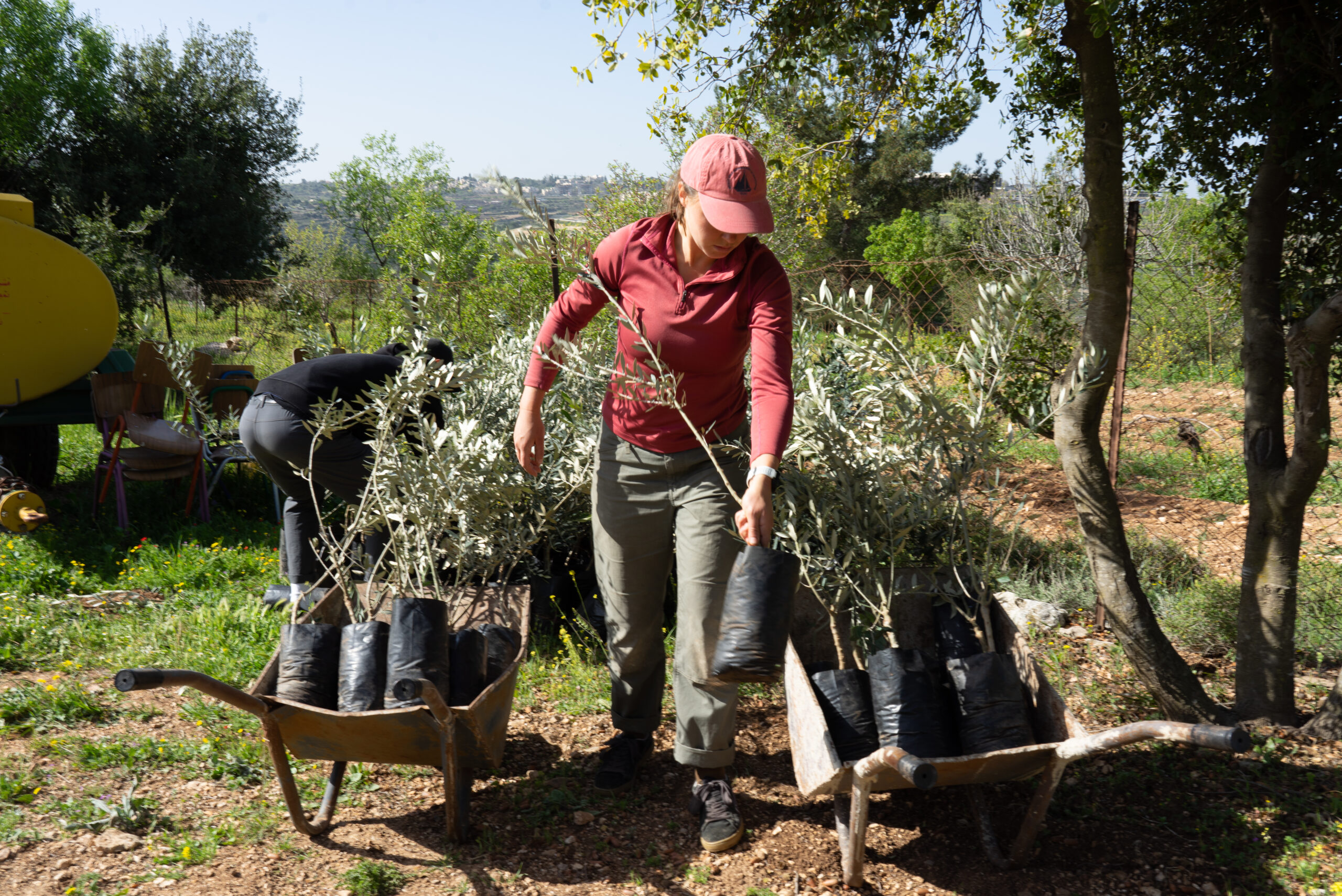
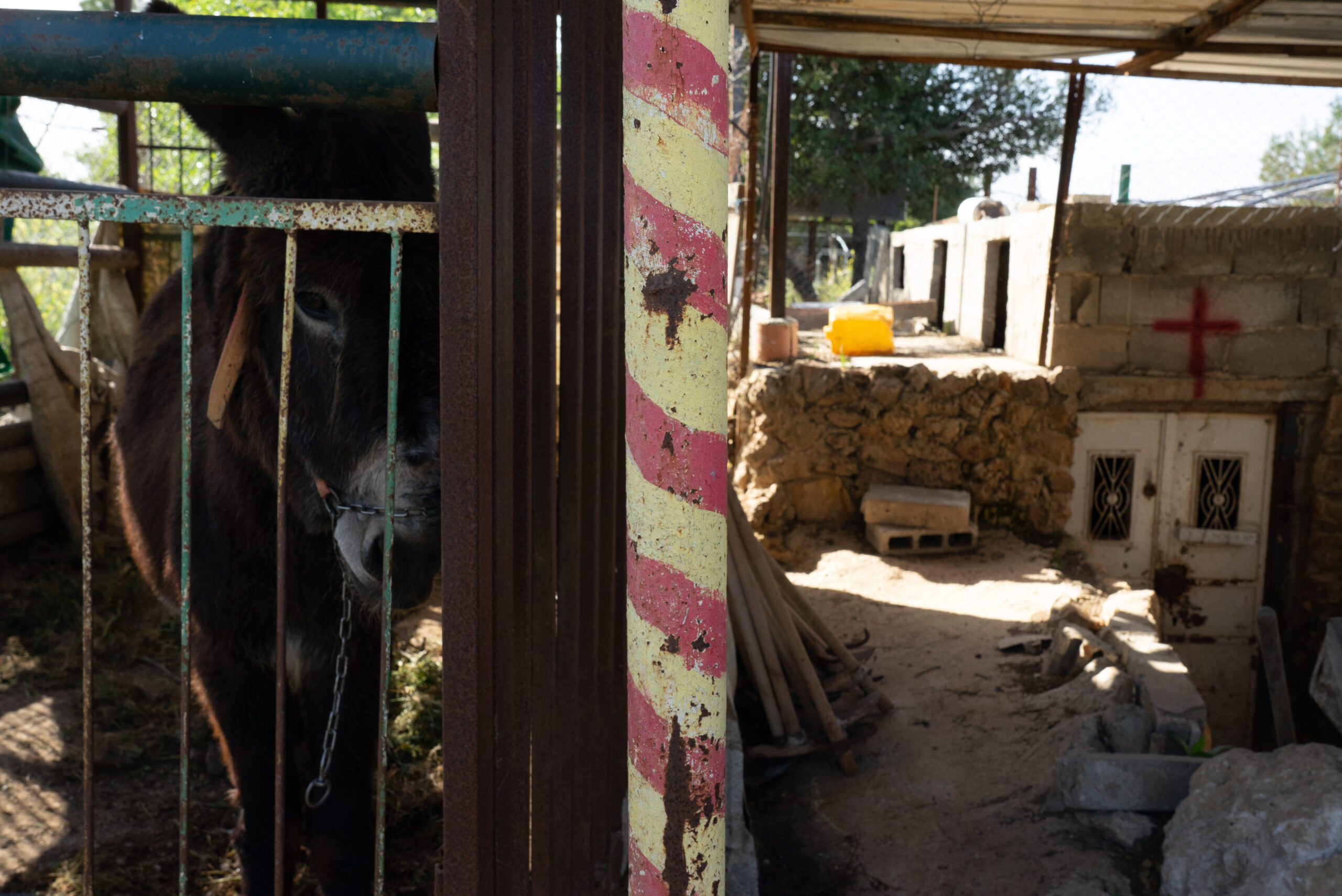
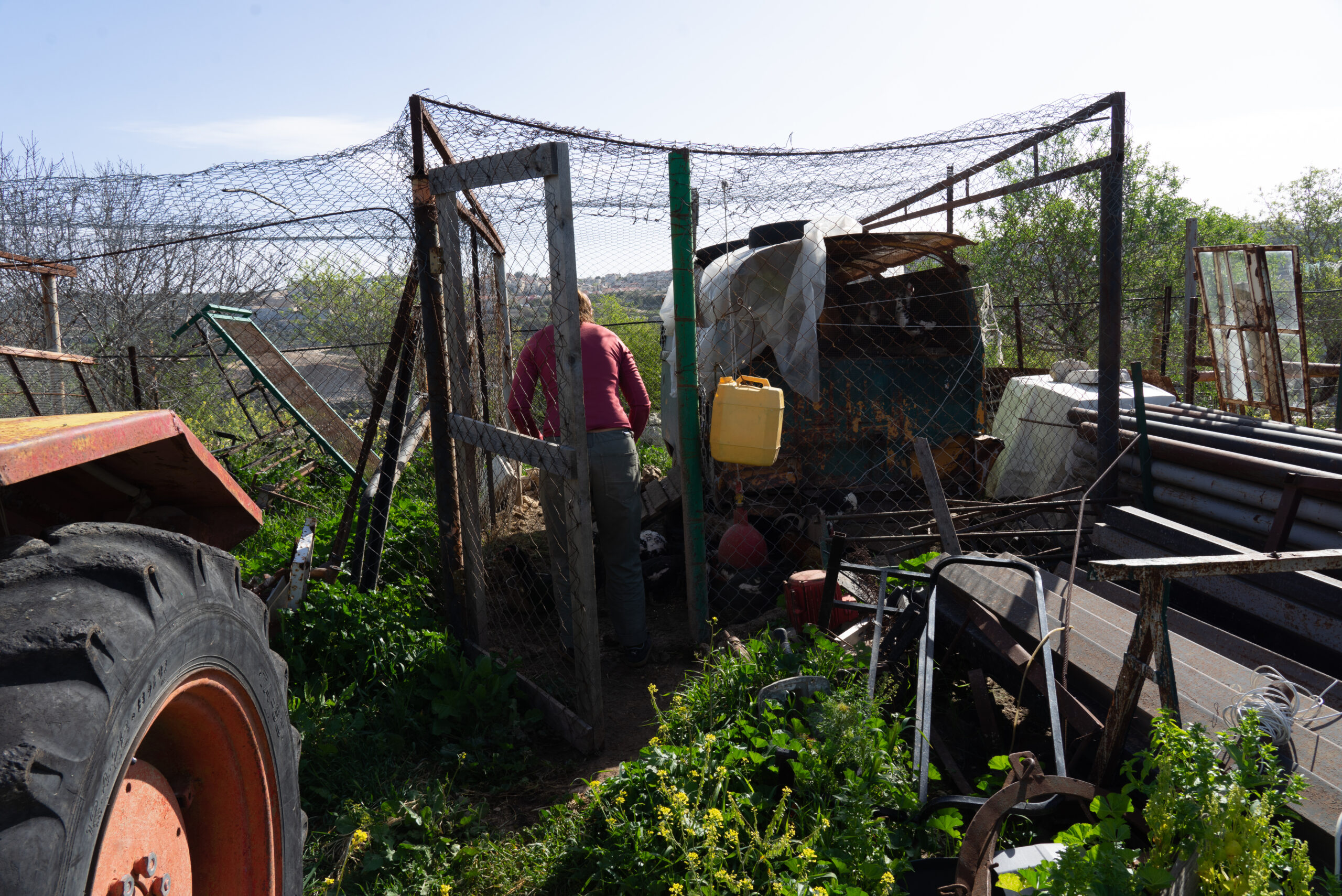

Amid Rising Attacks on Christian Sites in Jerusalem, a Growing Sense of Urgency Among Clergy and Advocates

JERUSALEM – Attacks on Christian holy sites and Christian clergy have risen precipitously in recent months. Sadly, examples abound. Days after the New Year, two Israeli Jewish teenagers were caught on camera vandalizing and destroying 30 graves at the Protestant Mount Zion Cemetery in Jerusalem.
Weeks later, a mob of settlers attacked an Armenian wine bar in the Old City, chanting, “death to Arabs, death to Christians.” In early February, a Jewish American tourist smashed a statue of Jesus inside the Church of the Flagellation, located on the Via Dolorosa. A video of the attack shows the perpetrator saying, “you can’t have idols in Jerusalem; this is the holy city” as someone tries to restrain him.
These represent only a fraction of attacks against Christian sites in Jerusalem. Many are perpetrated by radical Israeli Jewish groups seeking to create a more uniform Jewish character in the city, who have been emboldened by Israel’s current far-Right government, experts say.
The first two months of 2023 saw as many attacks as in all of 2022, according to data tracked by the Jerusalem Interchurch Center.
“It’s getting worse,” said Yousef Daher, the Center’s executive director. “There is an attack on the Christian identity” of Jerusalem. There have been incidents throughout Israel and in the West Bank, but much of the violence is centered on Jerusalem, where different religious communities are mixing to a greater extent, Daher said.
In recent years, efforts to track these attacks have been fragmented, with organizations using different methodologies to record the growing violence. For example, the Interchurch Center’s data tracks only attacks on property. The center characterized physical and verbal assaults against Christian clergy and worshipers as “countless.” (Anecdotally, the report cites one Armenian clergyman who claimed he has been spat on more than 90 times.)
But amid an outcry among Christian leaders in Jerusalem, there has been a growing effort to streamline different datasets, to more clearly demonstrate the scope of the problem and garner elusive international attention, said John Munayer, a Palestinian Christian activist and the director of international engagement at the Rossing Center for Education and Dialogue. The Rossing Center is in the midst of centralizing all of the datasets “floating around,” some of which have recorded only the large-scale attacks that make the news.
On an almost daily basis in Jerusalem, Munayer said, there are incidents where Christian clergy get taunted or slapped or spat on. “But many of the databases only record big events, like going into a church and knocking something down.”
He added that even the best data may be incomplete. Police are often slow to respond to these attacks, he said, so clergy have been deterred from reporting the incidents . For clergy from other countries, there is an added fear that if they speak up, the Israeli government may not renew their visas, said Mother Agapia, a former administrator of the Orthodox School of Bethany.
Mother Agapia said the violence has gotten “a little bit more aggressive” in recent months, and that its focus seems to be on diminishing the visible Christian presence throughout the country.
“It’s not so much of direct attacks on people; it’s more about making your mark,” she said. “It’s not about ‘don’t go to church’ – it’s more like we don’t want the mark of this Christianity” in our city.
Tania Berg-Refaeli, the director of World Religions for Israel’s Ministry of Foreign Affairs, said “there’s a feeling” attacks are increasing, though she was unaware of official Israeli government data on the issue.
The Israeli police, Berg-Refaeli said, are on top of the situation. “We observe an increase of the quick, swift reaction of the police that wasn’t the case before,” she said. “This was thanks to the understanding that something is happening and something needs to be done.”
A spokesman for the Israeli police did not respond to multiple requests for comment on efforts taken to track or combat attacks against Christian sites and clergy.
In response to the violence, multiple church leaders in Jerusalem formed the Protecting Holy Land Christians Campaign in late 2021. The campaign has been outspoken about attacks, reaching out to news organizations to highlight the trend. In late March, it posted an “Easter Message” on Twitter that cited “escalating violence” and indirectly criticized what it sees as a lackluster response by the Israeli government.
Attacks and targeting of Christian worship have come “in spite of our agreements to cooperate with governing authorities, and to accommodate any reasonable requests that they might present,” the message reads. “We ask the overseeing officials to work cooperatively and collaboratively with us.”
The organization compiled a dossier of attacks in the last 10 years, which it argues have endangered the “security and prosperity of Christians in Jerusalem, and the ability of local
Christians and international pilgrims to worship freely.”
Church leaders have argued that the attacks are one of the primary factors contributing to a shrinking Palestinian Christian population in Israel, relative to the size of other communities. (The precise figures are disputed, but Israeli government statistics show that Christians made up less than 2% of the Israeli population in 2022, compared to about 10% in 1948.) In a 2021 op-ed, the Catholic Church’s Custos of the Holy Land and guardian of the Christian holy places wrote that the lives of many Christians have been made “unbearable by radical local groups with extremist ideologies.”
“It seems that their aim is to free the Old City of Jerusalem from its Christian presence, even the Christian quarter,” he wrote.
Though many of the attackers are never identified, most fit a particular profile: “male, young, religious and…studying in yeshiva,” Munayer said. But the Rossing Center’s and Interchurch Center’s datasets do not include the identity of the perpetrators, and it can be difficult for police to determine their identity – especially in places where there are no surveillance cameras, said Berg-Refaeli.
Though she acknowledged that “obviously, most of the perpetrators are religious Jews,” she said that’s a broad category that could mask a range of different groups and beliefs. She sought to distance the larger Israeli society from these attacks, calling the perpetrators “marginal” and “extremists.”
“Unfortunately, like in any society, the extremists are more vocal, more predominant voice,” she added. “The silent moderate voices are not being heard.”
Multiple experts accused the Israeli government of inadequately responding to the attacks, and in many cases distancing itself by claiming the perpetrator suffered from mental illness or was not an Israeli citizen.
Many church leaders have decried what they see as a muted response from the international community to these attacks. After the mid-March attack at the Church of Gethsemane (whose perpetrator was actually Christian), the Patriarchate of Jerusalem released a statement emphasizing the near-daily nature of these attacks, and expressing frustration at the lack of international support the community has received.
“This dismal situation hasn’t drawn any appropriate reaction, locally or internationally, despite appeals, requests, and protests made by the Churches of the Holy Land,” the statement reads.
Among international Evangelical Christian organizations – some of whom provide significant political and financial support to Israel – the response has been muted. The Twitter feeds of Christians United for Israel (CUFI), the International Fellowship of Christians and Jews and Christian Friends of Israel make no mention of any of the attacks in 2023, focusing instead on threats facing Israel and the Jewish people. For example, on January 26, the date of the attack on the Armenian wine bar, CUFI posted seven times on Twitter but didn’t once mention the attack. Instead, it posted about rockets fired from Gaza, a Lebanese businessman’s ties to Hezbollah, and antisemitism and Holocaust remembrance.
The Fellowship posted twice that day – both about the history of Auschwitz and a “flashback” to the organization’s financial support for Holocaust survivors.
Robert Nicholson, the evangelical president of the Christian Philos Project, posted twice about the issue this year. Last week, he wrote that Philos “would get to the bottom of” rising incidents against Christians, promising “more on that soon.” Philos’s website includes a statement on its position on Christians of the Near East, affirming “the right of all Christians to live and flourish as indigenous citizens of the Near East.”
“Given the long history of discrimination and persecution, we believe that Near Eastern Christians deserve unique protections – even affirmative action – in order to preserve their language, culture, and religious practices,” the statement reads.
None of these organizations responded to multiple emails or calls requesting comment.
Munayer said there is growing international awareness of attacks on Christian sites, but it remains a sensitive issue for churches around the world who fear being branded as anti-Semitic for denouncing attacks largely committed by religious Israeli Jews.
For his part, Daher has seen international condemnations of attacks, but little action to back them up.
“It’s meaningless, really,” Daher said. “There is no pressure, no political fear. Without political pressure, you cannot get results.”
In a March blog post, Ophir Yarden, director of ADAShA: The Jerusalem Center for Interreligious Encounter at the Rossing Center, acknowledged churches’ calls for international support but noted that they should be entitled to support from the Israeli government.
“Failure to protect the Christians and their holy sites is to violate a solemn promise in Israel’s own Declaration of Independence,” Yarden wrote. “Both Hillel the Elder, as well as Jesus, taught that we must treat the religious other as we would want to be treated. This is a sacred obligation.”
Israel has long touted itself as a safe haven for Christians in a neighborhood of otherwise-hostile Muslim countries.
“If you are a Christian in the Middle East, there’s only one place where you are safe,” Prime Minister Benjamin Netanyahu’s office tweeted in 2018. In what has been a central message to Western audiences, he cast Israel as the only place in the region where “the Christian community is growing, thriving, prospering.”
His office did not respond to a request for comment about whether he still believes this to be true.

